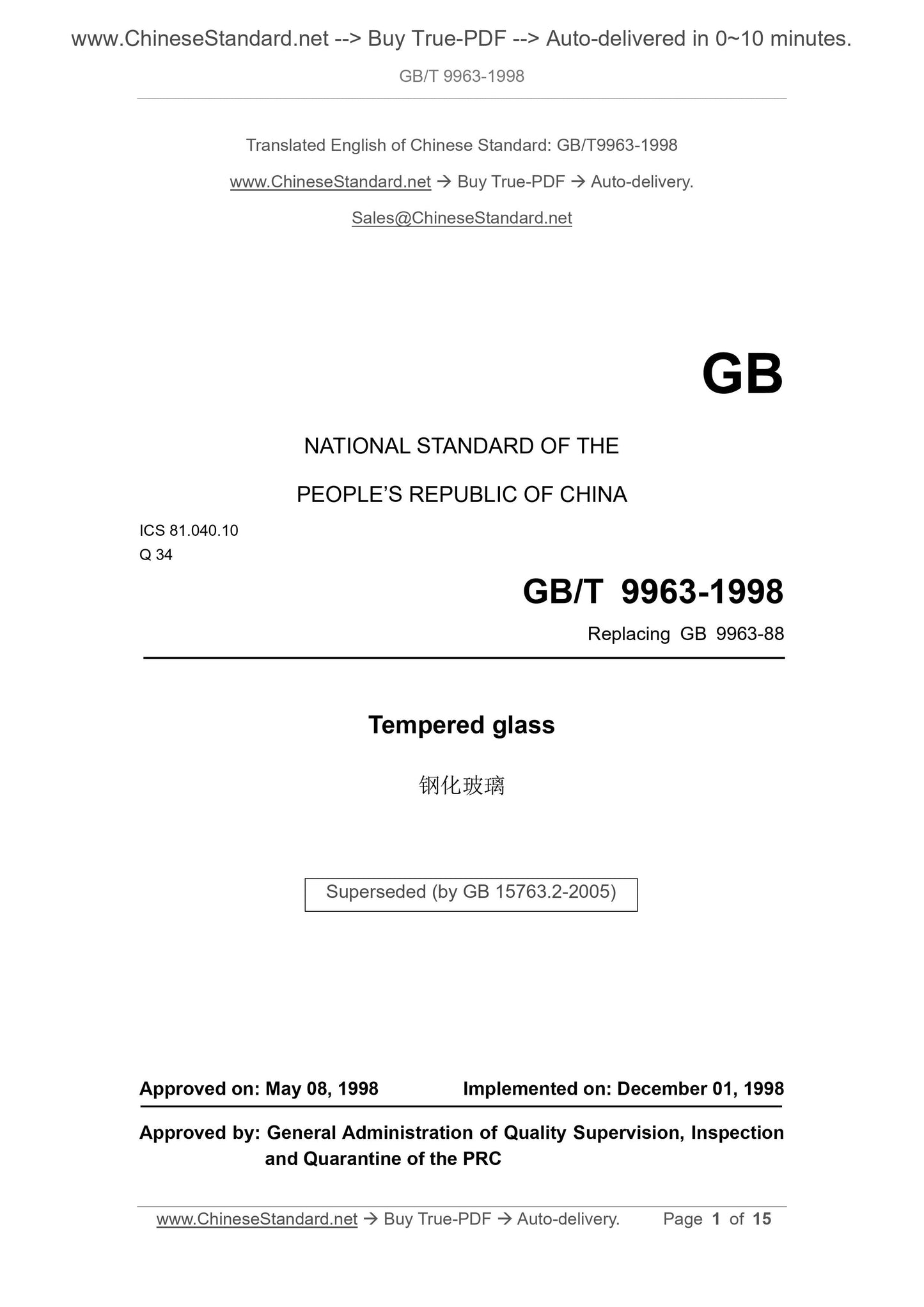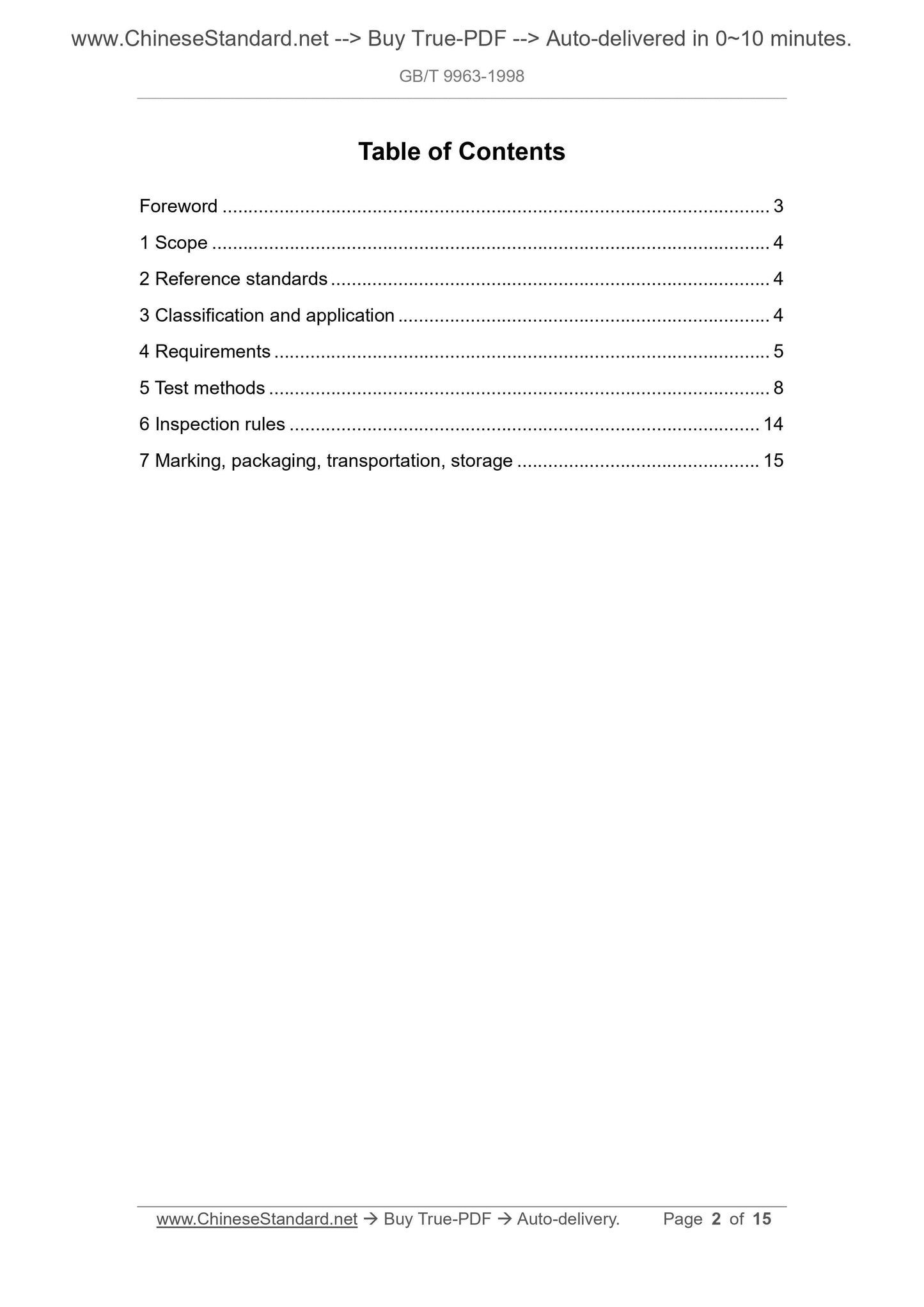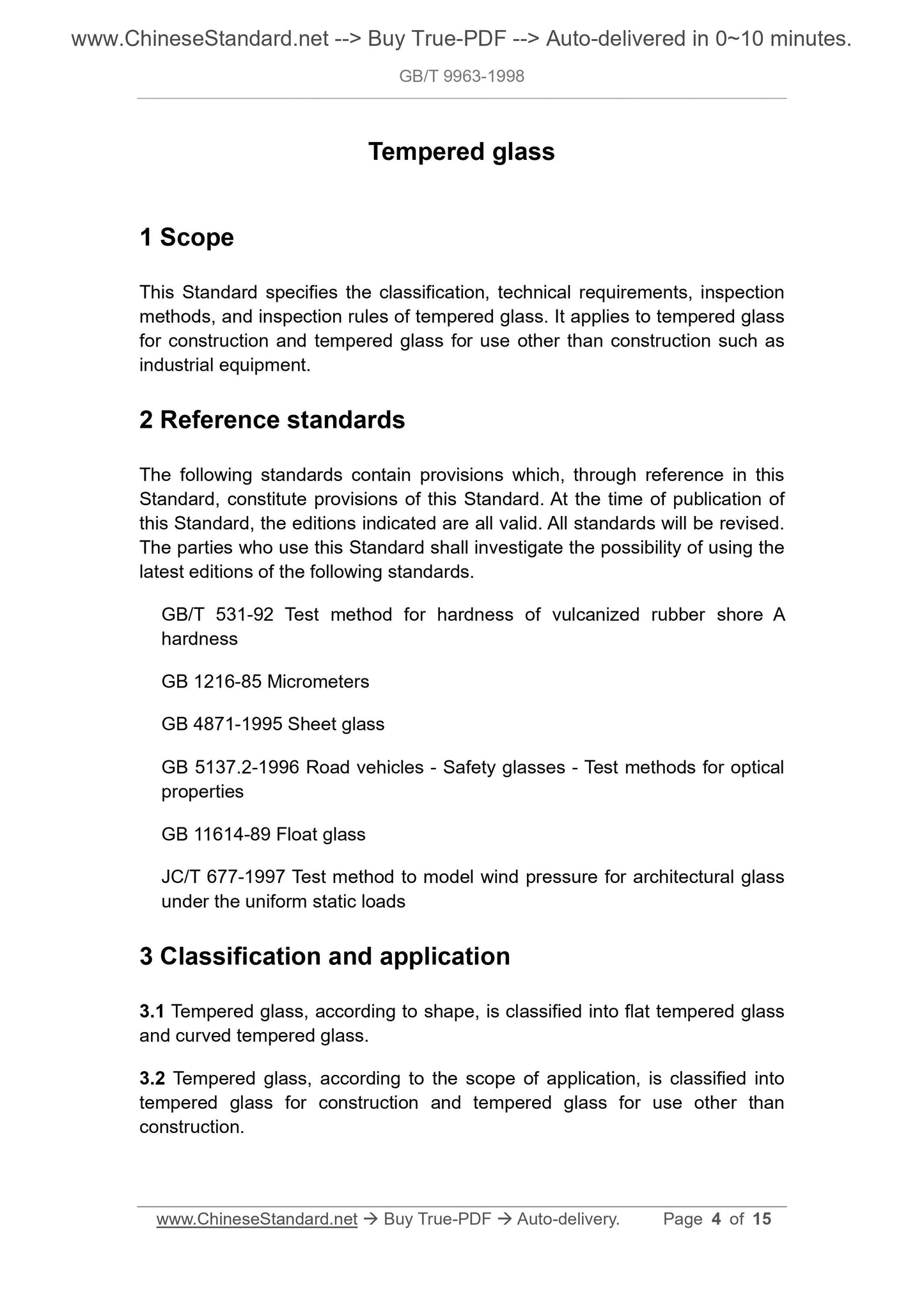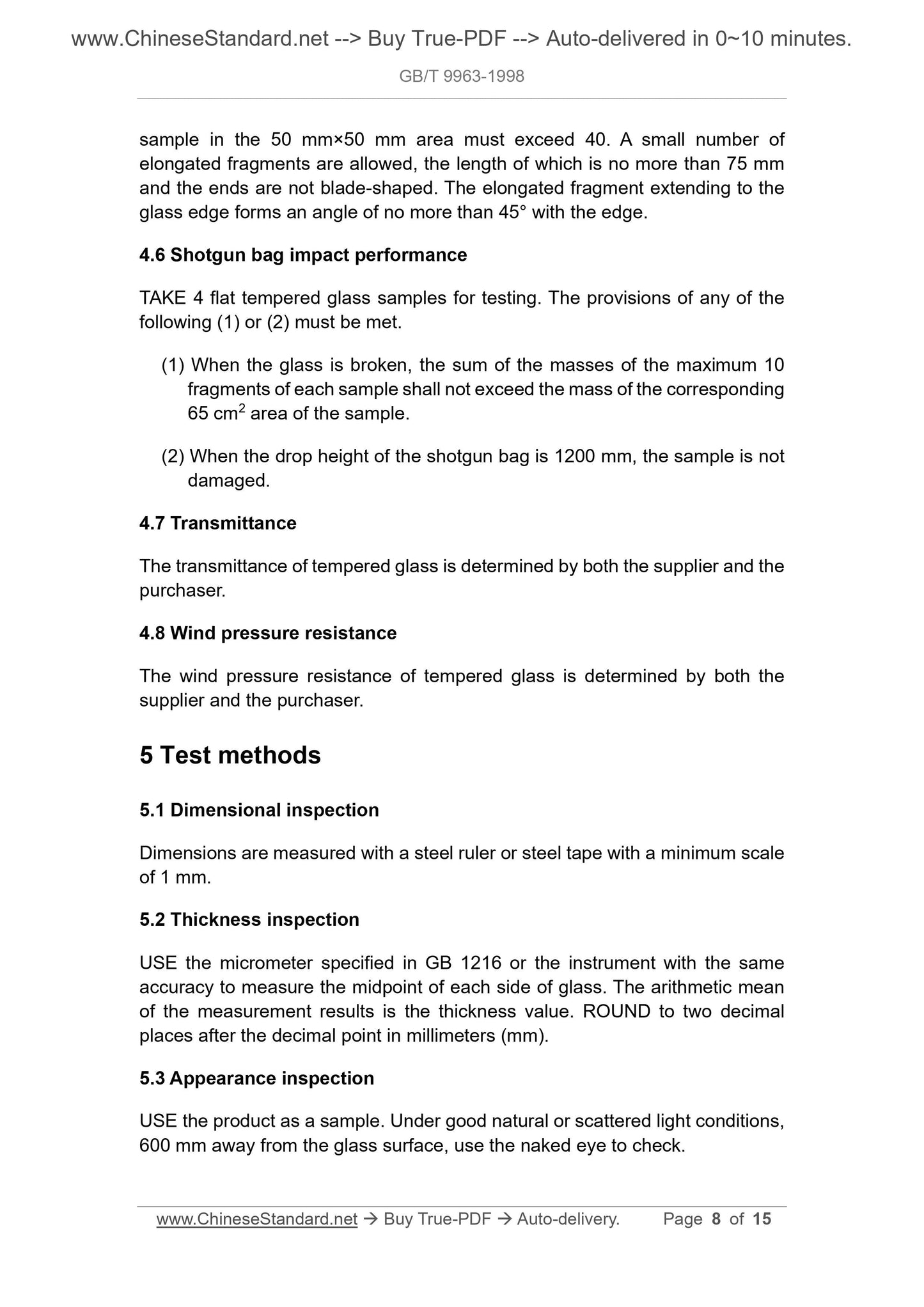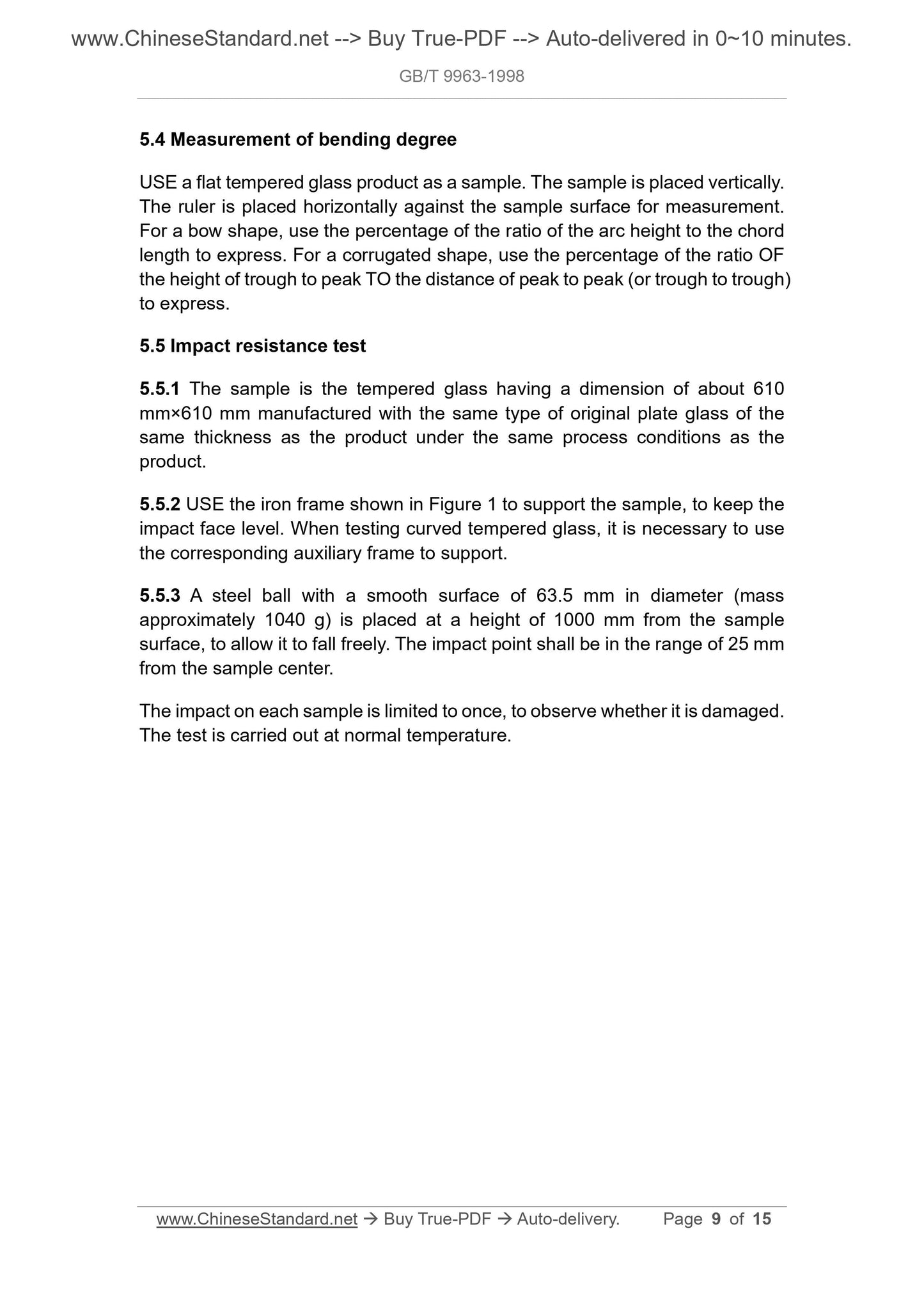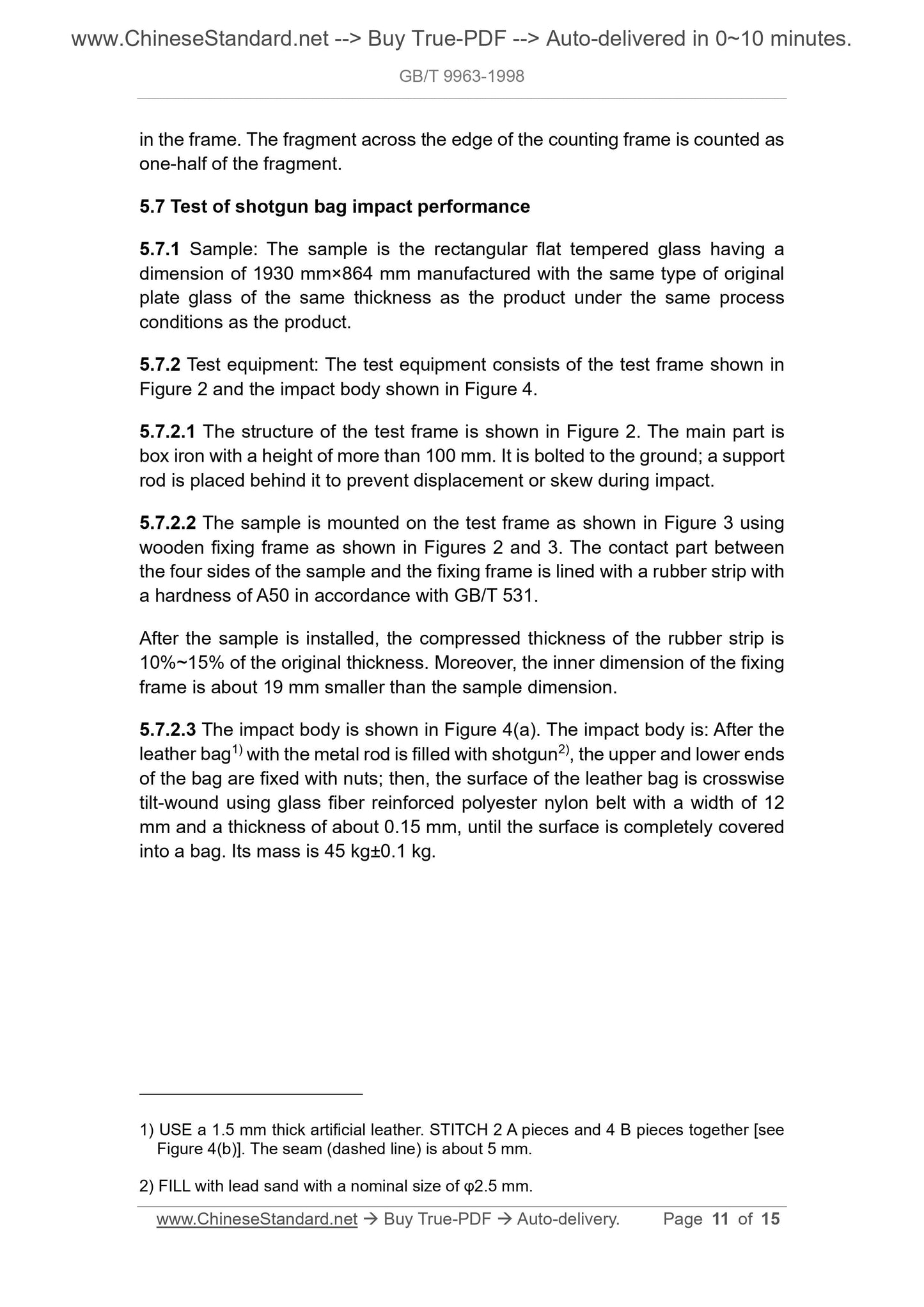1
/
の
6
PayPal, credit cards. Download editable-PDF and invoice in 1 second!
GB/T 9963-1998 English PDF (GBT9963-1998)
GB/T 9963-1998 English PDF (GBT9963-1998)
通常価格
$145.00 USD
通常価格
セール価格
$145.00 USD
単価
/
あたり
配送料はチェックアウト時に計算されます。
受取状況を読み込めませんでした
Delivery: 3 seconds. Download true-PDF + Invoice.
Get QUOTATION in 1-minute: Click GB/T 9963-1998
Historical versions: GB/T 9963-1998
Preview True-PDF (Reload/Scroll if blank)
GB/T 9963-1998: Tempered glass
GB/T 9963-1998
NATIONAL STANDARD OF THE
PEOPLE’S REPUBLIC OF CHINA
ICS 81.040.10
Q 34
Replacing GB 9963-88
Tempered glass
Superseded (by GB 15763.2-2005)
APPROVED ON: MAY 08, 1998
IMPLEMENTED ON: DECEMBER 01, 1998
Approved by: General Administration of Quality Supervision, Inspection
and Quarantine of the PRC
Table of Contents
Foreword ... 3
1 Scope ... 4
2 Reference standards ... 4
3 Classification and application ... 4
4 Requirements ... 5
5 Test methods ... 8
6 Inspection rules ... 14
7 Marking, packaging, transportation, storage ... 15
Tempered glass
1 Scope
This Standard specifies the classification, technical requirements, inspection
methods, and inspection rules of tempered glass. It applies to tempered glass
for construction and tempered glass for use other than construction such as
industrial equipment.
2 Reference standards
The following standards contain provisions which, through reference in this
Standard, constitute provisions of this Standard. At the time of publication of
this Standard, the editions indicated are all valid. All standards will be revised.
The parties who use this Standard shall investigate the possibility of using the
latest editions of the following standards.
GB/T 531-92 Test method for hardness of vulcanized rubber shore A
hardness
GB 1216-85 Micrometers
GB 4871-1995 Sheet glass
GB 5137.2-1996 Road vehicles - Safety glasses - Test methods for optical
properties
GB 11614-89 Float glass
JC/T 677-1997 Test method to model wind pressure for architectural glass
under the uniform static loads
3 Classification and application
3.1 Tempered glass, according to shape, is classified into flat tempered glass
and curved tempered glass.
3.2 Tempered glass, according to the scope of application, is classified into
tempered glass for construction and tempered glass for use other than
construction.
sample in the 50 mm×50 mm area must exceed 40. A small number of
elongated fragments are allowed, the length of which is no more than 75 mm
and the ends are not blade-shaped. The elongated fragment extending to the
glass edge forms an angle of no more than 45° with the edge.
4.6 Shotgun bag impact performance
TAKE 4 flat tempered glass samples for testing. The provisions of any of the
following (1) or (2) must be met.
(1) When the glass is broken, the sum of the masses of the maximum 10
fragments of each sample shall not exceed the mass of the corresponding
65 cm2 area of the sample.
(2) When the drop height of the shotgun bag is 1200 mm, the sample is not
damaged.
4.7 Transmittance
The transmittance of tempered glass is determined by both the supplier and the
purchaser.
4.8 Wind pressure resistance
The wind pressure resistance of tempered glass is determined by both the
supplier and the purchaser.
5 Test methods
5.1 Dimensional inspection
Dimensions are measured with a steel ruler or steel tape with a minimum scale
of 1 mm.
5.2 Thickness inspection
USE the micrometer specified in GB 1216 or the instrument with the same
accuracy to measure the midpoint of each side of glass. The arithmetic mean
of the measurement results is the thickness value. ROUND to two decimal
places after the decimal point in millimeters (mm).
5.3 Appearance inspection
USE the product as a sample. Under good natural or scattered light conditions,
600 mm away from the glass surface, use the naked eye to check.
5.4 Measurement of bending degree
USE a flat tempered glass product as a sample. The sample is placed vertically.
The ruler is placed horizontally against the sample surface for measurement.
For a bow shape, use the percentage of the ratio of the arc height to the chord
length to express. For a corrugated shape, use the percentage of the ratio OF
the height of trough to peak TO the distance of peak to peak (or trough to trough)
to express.
5.5 Impact resistance test
5.5.1 The sample is the tempered glass having a dimension of about 610
mm×610 mm manufactured with the same type of original plate glass of the
same thickness as the product under the same process conditions as the
product.
5.5.2 USE the iron frame shown in Figure 1 to support the sample, to keep the
impact face level. When testing curved tempered glass, it is necessary to use
the corresponding auxiliary frame to support.
5.5.3 A steel ball with a smooth surface of 63.5 mm in diameter (mass
approximately 1040 g) is placed at a height of 1000 mm from the sample
surface, to allow it to fall freely. The impact point shall be in the range of 25 mm
from the sample center.
The impact on each sample is limited to once, to observe whether it is damaged.
The test is carried out at normal temperature.
in the frame. The fragment across the edge of the counting frame is counted as
one-half of the fragment.
5.7 Test of shotgun bag impact performance
5.7.1 Sample: The sample is the rectangular flat tempered glass having a
dimension of 1930 mm×864 mm manufactured with the same type of original
plate glass of the same thickness as the product under the same process
conditions as the product.
5.7.2 Test equipment: The test equipment consists of the test frame shown in
Figure 2 and the impact body shown in Figure 4.
5.7.2.1 The structure of the test frame is shown in Figure 2. The main part is
box iron with a height of more than 100 mm. It is bolted to the ground; a support
rod is placed behind it to prevent displacement or skew during impact.
5.7.2.2 The sample is mounted on the test frame as shown in Figure 3 using
wooden fixing frame as shown in Figures 2 and 3. The contact part between
the four sides of the sample and the fixing frame is lined with a rubber strip with
a hardness of A50 in accordance with GB/T 531.
After the sample is installed, the compressed thickness of the rubber strip is
10%~15% of the original thickness. Moreover, the inner dimension of the fixing
frame is about 19 mm smaller than the sample dimension.
5.7.2.3 The impact body is shown in Figure 4(a). The impact body is: After the
leather bag1) with the metal rod is filled with shotgun2), the upper and lower ends
of the bag are fixed with nuts; then, the surface of the leather bag is crosswise
tilt-wound using glass fiber reinforced polyester nylon belt with a width of 12
mm and a thickness of about 0.15 mm, until the surface is completely covered
into a bag. Its mass is 45 kg±0.1 kg.
1) USE a 1.5 mm thick artificial leather. STITCH 2 A pieces and 4 B pieces together [see
Figure 4(b)]. The seam (dashed line) is about 5 mm.
2) FILL with lead sand with a nominal size of φ2.5 mm.
Get QUOTATION in 1-minute: Click GB/T 9963-1998
Historical versions: GB/T 9963-1998
Preview True-PDF (Reload/Scroll if blank)
GB/T 9963-1998: Tempered glass
GB/T 9963-1998
NATIONAL STANDARD OF THE
PEOPLE’S REPUBLIC OF CHINA
ICS 81.040.10
Q 34
Replacing GB 9963-88
Tempered glass
Superseded (by GB 15763.2-2005)
APPROVED ON: MAY 08, 1998
IMPLEMENTED ON: DECEMBER 01, 1998
Approved by: General Administration of Quality Supervision, Inspection
and Quarantine of the PRC
Table of Contents
Foreword ... 3
1 Scope ... 4
2 Reference standards ... 4
3 Classification and application ... 4
4 Requirements ... 5
5 Test methods ... 8
6 Inspection rules ... 14
7 Marking, packaging, transportation, storage ... 15
Tempered glass
1 Scope
This Standard specifies the classification, technical requirements, inspection
methods, and inspection rules of tempered glass. It applies to tempered glass
for construction and tempered glass for use other than construction such as
industrial equipment.
2 Reference standards
The following standards contain provisions which, through reference in this
Standard, constitute provisions of this Standard. At the time of publication of
this Standard, the editions indicated are all valid. All standards will be revised.
The parties who use this Standard shall investigate the possibility of using the
latest editions of the following standards.
GB/T 531-92 Test method for hardness of vulcanized rubber shore A
hardness
GB 1216-85 Micrometers
GB 4871-1995 Sheet glass
GB 5137.2-1996 Road vehicles - Safety glasses - Test methods for optical
properties
GB 11614-89 Float glass
JC/T 677-1997 Test method to model wind pressure for architectural glass
under the uniform static loads
3 Classification and application
3.1 Tempered glass, according to shape, is classified into flat tempered glass
and curved tempered glass.
3.2 Tempered glass, according to the scope of application, is classified into
tempered glass for construction and tempered glass for use other than
construction.
sample in the 50 mm×50 mm area must exceed 40. A small number of
elongated fragments are allowed, the length of which is no more than 75 mm
and the ends are not blade-shaped. The elongated fragment extending to the
glass edge forms an angle of no more than 45° with the edge.
4.6 Shotgun bag impact performance
TAKE 4 flat tempered glass samples for testing. The provisions of any of the
following (1) or (2) must be met.
(1) When the glass is broken, the sum of the masses of the maximum 10
fragments of each sample shall not exceed the mass of the corresponding
65 cm2 area of the sample.
(2) When the drop height of the shotgun bag is 1200 mm, the sample is not
damaged.
4.7 Transmittance
The transmittance of tempered glass is determined by both the supplier and the
purchaser.
4.8 Wind pressure resistance
The wind pressure resistance of tempered glass is determined by both the
supplier and the purchaser.
5 Test methods
5.1 Dimensional inspection
Dimensions are measured with a steel ruler or steel tape with a minimum scale
of 1 mm.
5.2 Thickness inspection
USE the micrometer specified in GB 1216 or the instrument with the same
accuracy to measure the midpoint of each side of glass. The arithmetic mean
of the measurement results is the thickness value. ROUND to two decimal
places after the decimal point in millimeters (mm).
5.3 Appearance inspection
USE the product as a sample. Under good natural or scattered light conditions,
600 mm away from the glass surface, use the naked eye to check.
5.4 Measurement of bending degree
USE a flat tempered glass product as a sample. The sample is placed vertically.
The ruler is placed horizontally against the sample surface for measurement.
For a bow shape, use the percentage of the ratio of the arc height to the chord
length to express. For a corrugated shape, use the percentage of the ratio OF
the height of trough to peak TO the distance of peak to peak (or trough to trough)
to express.
5.5 Impact resistance test
5.5.1 The sample is the tempered glass having a dimension of about 610
mm×610 mm manufactured with the same type of original plate glass of the
same thickness as the product under the same process conditions as the
product.
5.5.2 USE the iron frame shown in Figure 1 to support the sample, to keep the
impact face level. When testing curved tempered glass, it is necessary to use
the corresponding auxiliary frame to support.
5.5.3 A steel ball with a smooth surface of 63.5 mm in diameter (mass
approximately 1040 g) is placed at a height of 1000 mm from the sample
surface, to allow it to fall freely. The impact point shall be in the range of 25 mm
from the sample center.
The impact on each sample is limited to once, to observe whether it is damaged.
The test is carried out at normal temperature.
in the frame. The fragment across the edge of the counting frame is counted as
one-half of the fragment.
5.7 Test of shotgun bag impact performance
5.7.1 Sample: The sample is the rectangular flat tempered glass having a
dimension of 1930 mm×864 mm manufactured with the same type of original
plate glass of the same thickness as the product under the same process
conditions as the product.
5.7.2 Test equipment: The test equipment consists of the test frame shown in
Figure 2 and the impact body shown in Figure 4.
5.7.2.1 The structure of the test frame is shown in Figure 2. The main part is
box iron with a height of more than 100 mm. It is bolted to the ground; a support
rod is placed behind it to prevent displacement or skew during impact.
5.7.2.2 The sample is mounted on the test frame as shown in Figure 3 using
wooden fixing frame as shown in Figures 2 and 3. The contact part between
the four sides of the sample and the fixing frame is lined with a rubber strip with
a hardness of A50 in accordance with GB/T 531.
After the sample is installed, the compressed thickness of the rubber strip is
10%~15% of the original thickness. Moreover, the inner dimension of the fixing
frame is about 19 mm smaller than the sample dimension.
5.7.2.3 The impact body is shown in Figure 4(a). The impact body is: After the
leather bag1) with the metal rod is filled with shotgun2), the upper and lower ends
of the bag are fixed with nuts; then, the surface of the leather bag is crosswise
tilt-wound using glass fiber reinforced polyester nylon belt with a width of 12
mm and a thickness of about 0.15 mm, until the surface is completely covered
into a bag. Its mass is 45 kg±0.1 kg.
1) USE a 1.5 mm thick artificial leather. STITCH 2 A pieces and 4 B pieces together [see
Figure 4(b)]. The seam (dashed line) is about 5 mm.
2) FILL with lead sand with a nominal size of φ2.5 mm.
Share
